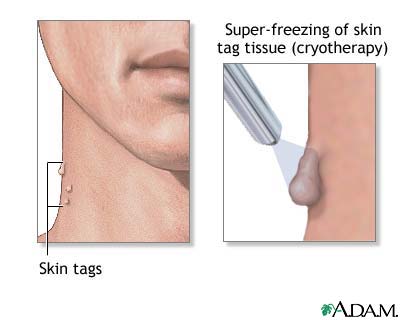Health Library
Cutaneous skin tag
Skin tag; Acrochordon; Fibroepithelial polyp
A cutaneous skin tag is a common skin growth. Most of the time, it is harmless.
Images

I Would Like to Learn About:
Causes
A cutaneous tag most often occurs in older adults. They are more common in people who are overweight or who have diabetes. They are thought to occur from skin rubbing against skin.
Symptoms
The tag sticks out of the skin and may have a short, narrow stalk connecting it to the surface of the skin. Some skin tags are as long as a half an inch (1 centimeter). Most skin tags are the same color as skin, or a little darker.
In most cases, a skin tag is painless and does not grow or change. However, it may become irritated from rubbing by clothing or other materials.
Places where skin tags occur include:
- Neck
- Underarms
- Middle of the body, or under folds of skin
- Eyelids
- Inner thighs
- Other body areas
Exams and Tests
Your health care provider can diagnose this condition by looking at your skin. Sometimes a skin biopsy is done.
Treatment
Treatment is often not needed. Your provider may recommend treatment if the skin tag is irritating or you don't like how it looks. Treatment may include:
- Surgery to remove it
- Freezing it (cryotherapy)
- Burning it off (cauterization)
- Tying string or dental floss around it to cut off the blood supply so that it will eventually fall off
Outlook (Prognosis)
A skin tag is most often harmless (benign). It may become irritated if clothing rubs against it. In most cases, the growth usually does not grow back after it is removed. However, new skin tags may form on other parts of the body.
When to Contact a Medical Professional
Contact your provider if the skin tag changes or if you want it removed. Do not cut it yourself, because it can bleed a lot.
Related Information
BenignReferences
Dinulos JGH. Benign skin tumors. In: Dinulos JGH, ed. Habif's Clinical Dermatology: A Color Guide in Diagnosis and Therapy. 7th ed. Philadelphia, PA: Elsevier; 2021:chap 20.
James WD, Elston DM, Treat JR, Rosenbach MA, Neuhaus IM. Dermal and subcutaneous tumors. In: James WD, Elston DM, Treat JR, Rosenbach MA, Neuhaus IM, eds. Andrews' Diseases of the Skin: Clinical Dermatology. 13th ed. Philadelphia, PA: Elsevier; 2020:chap 28.
Pfenninger JL. Approach to various skin lesions. In: Fowler GC, ed. Pfenninger and Fowler's Procedures for Primary Care. 4th ed. Philadelphia, PA: Elsevier; 2020:chap 13.
BACK TO TOPReview Date: 7/8/2023
Reviewed By: Linda J. Vorvick, MD, Clinical Professor, Department of Family Medicine, UW Medicine, School of Medicine, University of Washington, Seattle, WA. Also reviewed by David C. Dugdale, MD, Medical Director, Brenda Conaway, Editorial Director, and the A.D.A.M. Editorial team.
 | A.D.A.M., Inc. is accredited by URAC, for Health Content Provider (www.urac.org). URAC's accreditation program is an independent audit to verify that A.D.A.M. follows rigorous standards of quality and accountability. A.D.A.M. is among the first to achieve this important distinction for online health information and services. Learn more about A.D.A.M.'s editorial policy, editorial process and privacy policy. A.D.A.M. is also a founding member of Hi-Ethics. This site complies with the HONcode standard for trustworthy health information: verify here. |
The information provided herein should not be used during any medical emergency or for the diagnosis or treatment of any medical condition. A licensed medical professional should be consulted for diagnosis and treatment of any and all medical conditions. Links to other sites are provided for information only -- they do not constitute endorsements of those other sites. No warranty of any kind, either expressed or implied, is made as to the accuracy, reliability, timeliness, or correctness of any translations made by a third-party service of the information provided herein into any other language. © 1997- 2024 A.D.A.M., a business unit of Ebix, Inc. Any duplication or distribution of the information contained herein is strictly prohibited.
